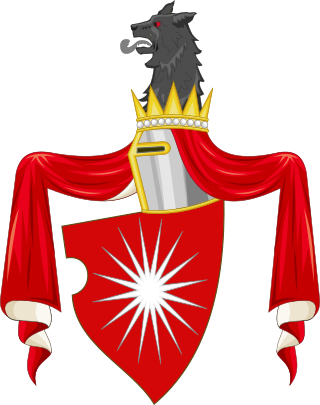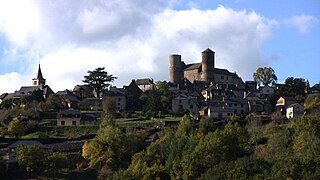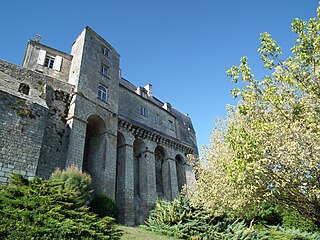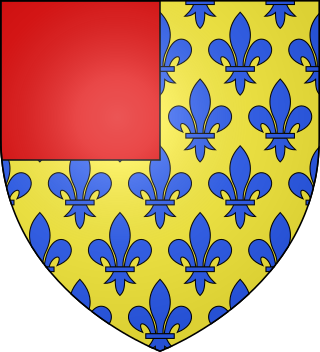Related Research Articles

Philippa of Hainault was Queen of England as the wife and political adviser of King Edward III. She acted as regent in 1346, when her husband was away for the Hundred Years' War.

Margaret II of Avesnes was Countess of Hainaut and Countess of Holland from 1345 to 1356. She was Holy Roman Empress and Queen of Germany by marriage to Holy Roman Emperor Louis IV the Bavarian.

Fulk III, the Black was an early Count of Anjou celebrated as one of the first great builders of medieval castles. It is estimated Fulk constructed approximately 100 castles as well as abbeys throughout the Loire Valley in what is now France. He fought successive wars with neighbors in Brittany, Blois, Poitou and Aquitaine and made four pilgrimages to Jerusalem during the course of his life. He had two wives and three children.

Aubeterre-sur-Dronne, commonly referred to as Aubeterre, is a commune in the Charente department in the Nouvelle-Aquitaine region of Southwestern France.

Aunis is a historical province of France, situated in the north-west of the department of Charente-Maritime. Its historic capital is La Rochelle, which took over from Castrum Allionis (Châtelaillon) the historic capital which gives its name to the province.

The House of Baux is a French noble family from the south of France. It was one of the richest and most powerful families of medieval Provence, known as the 'Race d’Aiglon'. They were independent lords as castellans of Les Baux and Arles and wielded very considerable authority at the local level. They held important fiefs and vast lands, including the principality of Orange.

The Château de Beynac is a castle situated in the commune of Beynac-et-Cazenac, in the Dordogne département of France. The castle is one of the best-preserved and best known in the region.
Yolanda of Lusignan or Yolande I de Lusignan, Countess of La Marche was a French noblewoman and peeress. In 1308, she succeeded her brother Guy I as suo jure Dame of Lusignan, of Couhé and of Peyrat, and suo jure Countess of La Marche, but not as Countess of Angoulême since after her brother's death the county was sold by her sisters, Joan and Isabelle, to King Philip IV and annexed to the French Crown. Yolanda was also the heiress of Fougères, which she succeeded to upon her mother's death sometime after 1273.

Pomayrols is a commune in the Aveyron department in southern France.

Pons is a commune in the Charente-Maritime department in southwestern France. The city is known for its numerous national historic monuments dating from the 12th century onward. One of the most well known is the 33 m Keep of Pons, which is the official symbol of the city.

Lussac-les-Châteaux is a commune in the Vienne department in the Nouvelle-Aquitaine region in western France.

UNESCO designated the Routes of Santiago de Compostela in France as a World Heritage Site in December 1998. The routes pass through the following regions of France: Aquitaine, Auvergne, Basse-Normandie, Bourgogne, Centre, Champagne-Ardenne, Ile-de-France, Languedoc-Roussillon, Limousin, Midi-Pyrénées, Picardie, Poitou-Charentes, and Provence-Alpes-Côte d'Azur. UNESCO cites the routes' role in "religious and cultural exchange", the development of "specialized edifices" along the routes, and their "exceptional witness to the power and influence of Christian faith among people of all classes and countries in Europe during the Middle Ages".

Aimery IV viscount of Thouars was a companion of William the Conqueror on his Invasion of England in 1066.
François Jourda de Vaux de Foletier, also called François de Vaux de Foletier, was a 20th-century French archivist and historian, a specialist of the history of the Romani people in Europe.

Renaud II, also known as Reginald de Pontibus or Renaud de Ponz, was a French nobleman and the lord of Pons in the Saintonge region of the County of Poitou from 1191 until his death. In the Anglo-French dynastic conflict, he was a strong supporter of John, King of England. He left Poitou three times to fight infidels: the Third Crusade, the Reconquista in Spain and the Seventh Crusade. He is distinguished from his uncle, Renaud de Pons, Seneschal of Gascony, in contemporary documents by the epithets senior and junior. He is possibly the same person as the troubadour Rainaut de Pons.

Renaud de Pons was a nobleman from the Saintonge. He served as Seneschal of Gascony between 1214 and 1217 and briefly as Seneschal of Poitou in 1216. He went on the Fifth Crusade in 1217–21. He and his nephew, Renaud II de Pons, are distinguished in contemporary documents by the epithets senior and iunior. He is also known by the epithet Palmarius because he was a crusader.

The Keep of Pons is an 830-year-old fortified tower located in Pons, France and is one of the few remnants of the original castle of Pons. The keep is located near the chapel and porch of Saint Gilles and remains of the ramparts. On a hill and visible from a distance, this 33-meter-high (108 ft) edifice is used as the symbol of the city.

Laugier of Nice, known as the Roux, is also known as Laugier of Orange-Mévouillon or Laugier of Vence. He was co-lord of Nice, Gréolières, Cagnes and Vence. He held these titles in part through his wife Odile of Provence and his father-in-law, William I of Provence. Laugier seems to be related to the Mévouillon-Orange lineage. Some historians give him the title of viscount. He was a member of the first house of the counts of Orange-Nice. From 1023 Laugier was a monk of the order of Cluny.

Geoffrey of Lusignan was the Lord of Vouvant and Soubise, and Count of Jaffa and Ascalon. He was also Lord of Mervent and Moncontour by his wife's rights.
References
- Combes, Jean (1985). Guide des départements : la Charente-Maritime, par (ouvrage collectif sous la direction de).
- Vaux de Foletier, François de (1929). Histoire d'Aunis et de Saintonge (in French). Paris: Boivin & cie. OCLC 1153384342.